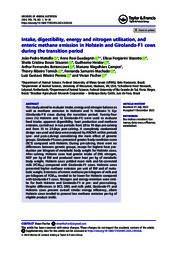Intake, digestibility, energy and nitrogen utilisation, and enteric methane emission in Holstein and Girolando-F1 cows during the transition period.
Intake, digestibility, energy and nitrogen utilisation, and enteric methane emission in Holstein and Girolando-F1 cows during the transition period.
Author(s): MATIELLO, J. P.; GUADAGNIN, A. R.; VIZZOTTO, E. F.; STIVANIN, S. C. B.; HEISLER, G.; BETTENCOURT, A. F.; CAMPOS, M. M.; TOMICH, T. R.; MACHADO, F. S.; PEREIRA, L. G. R.; FISCHER, V.
Summary: This study aimed to evaluate intake, energy and nitrogen balance as well as methane emission in Holstein and ½ Holstein ½ Gyr (Girolando-F1) cows during the transition period. Twenty-four cows (12 Holstein and 12 Girolando-F1) were used to evaluate feed intake, apparent digestibility, heat production and methane emission, carried out in two periods: from 28 to 19?days pre-calving and from 15 to 23?days post-calving. A completely randomised design was used and data were analysed by ANOVA within periods (pre- and post-calving) considering the main effect of genetic groups. Girolando-F1cows presented greater body condition score (BCS) compared with Holstein. During pre-calving, there were no differences between genetic groups, except for highest heat production per kilogram of metabolic body weight for Holstein cows. After calving, Holstein cows had greater intake of DM, nitrogen, NDF per kg of BW and produced more heat per kg of metabolic body weight. Holstein cows yielded more milk and fat-corrected milk (FCM4%) compared with Girolando-F1 cows. Holstein cows presented higher methane emission per unit of BW and of metabolic weight. Emissions of enteric methane per kilogram of milk and per kilogram of FCM4% tended to be lower for Holstein compared with Girolando-F1 cows. Nitrogen and energy retention were similar for both Holstein and Girolando-F1 at pre- and post-calving. Despite differences in BCS, DMI, and milk yield, Girolando-F1 and Holstein cows present overall similar energy efficiency, albeit Holstein cows tended to present less methane emission per kg of eligible product (milk).
Publication year: 2024
Types of publication: Journal article
Unit: Embrapa Dairy Cattle
Keywords: Bos Indicus, Bovino, Eficiência, Gado Leiteiro, Gado Mestiço, Metabolismo Animal
Observation
Some of Embrapa's publications are published as ePub files. To read them, use or download one of the following free software options to your computer or mobile device. Android: Google Play Books; IOS: iBooks; Windows and Linux: Calibre.
Access other publications
Access the Agricultural Research Database (BDPA) to consult Embrapa's full library collection and records.
Visit Embrapa Bookstore to purchase books and other publications sold by Embrapa.

